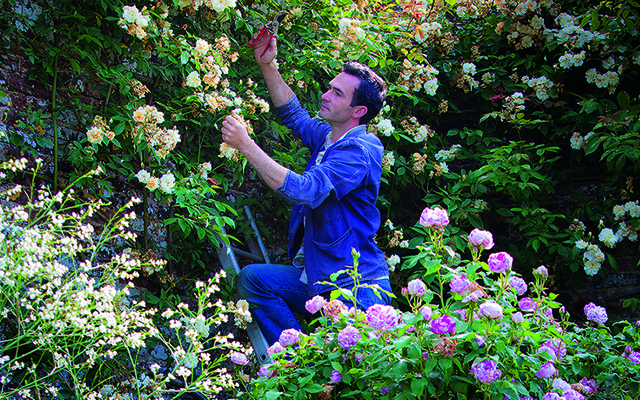Tips on deadheading roses
Troy Scott Smith extols the joys of deadheading roses.


When I returned to Sissinghurst in early spring 2013, I planted one of my favourite roses, the rambler Albertine, to climb up the front of our cottage. In just three seasons, it has soared to the first floor and now, when I sit at my desk, the delicate fragrance of its blooms a cocktail of freshly cut meadow grass and tinned pineapple streams in through an open window. For three weeks in June, the air at Sissinghurst hangs heavy with the lovely perfume of 100 roses.
Vita was particularly fascinated by plants with historical or literary associations, her passion for plants having been shaped by her love of the old Dutch flower paintings and by the plant species she saw on her travels to places such as Persia and the Alps.
The romantic associations of old flowers, with their connections to the past, to painters and far-away places, influenced her choice. Of all Sissinghurst’s flowers, it was the rose that most captured Vita’s imagination and so it is that roses are typical of its soft abundance, subtlety and romance.
Both Vita and Harold felt that Sissinghurst ‘lent itself kindly to their untidy, lavish habit; there was space a plenty, with the walls to frame their exuberance’; consequently, ‘roses may be found growing in a jungle, sprawling, intertwining, barely tamed and foaming in an unorthodox way’.
Vita’s earliest roses were grown in what is now the White Garden, but it wasn’t long before her collection outgrew that space and a new Rose Garden was created in the Rondel Garden in 1937 to accommodate them. Vita filled it with every kind of old rose, including masses of climbers that covered virtually every available wall.
Her diaries and notebooks have abundant references to roses and there are records of purchases from, among others, Bunyard of Maid-stone, Hilda Murrell, Graham Stuart Thomas at Hillings and Constance Spry. Relishing their colours, scent, form and beauty, she felt that their merits far outweighed their flowering only once during a season.
When we say ‘old roses’, what we mean are all those that were bred before 1867, when the first Hybrid Tea called La France appeared. They are divided up into several groups: centifolias, albas, gallicas, Mosses, Damasks and Bourbons. Unlike modern roses, unless judicious and skilled winter pruning is carried out, the blooms of all these old roses will be few and fleeting.
Sign up for the Country Life Newsletter
Exquisite houses, the beauty of Nature, and how to get the most from your life, straight to your inbox.
The technique involves pulling the long, supple wands of growth made this season down in an arc and anchoring them in position. This bending of shoots horizontally prevents the sap simply rising to the top of each stem; instead, flowers will be encouraged to break out from every joint. The basic principles of removing dead, diseased, weak and crossing growth remains the same and all of the remaining shoots should be shortened by about a third.
A proportion of the older wood should be removed completely to encourage strong growth shoots from the base. A balance bet-ween production of flowering wood and growth wood to form a framework is the desirable optimum. Remember, the harder you prune and the less bend you put on a shoot, the more extension growth will be produced. Those shoots bent more horizontally will be studded with flowers along their entire length.
With the old roses, it’s more important during the flowering season to make time to dead- head spent flowers for every perfect bloom, there will be another two or three that have finished and will be unsightly unless removed. At Sissinghurst, we’re fortunate to have two teams of volunteers who come over an eight-week period to help (the only criterion is to leave those roses that produce decorative hips later in the year).
Country Life is unlike any other magazine: the only glossy weekly on the newsstand and the only magazine that has been guest-edited by HRH The King not once, but twice. It is a celebration of modern rural life and all its diverse joys and pleasures — that was first published in Queen Victoria's Diamond Jubilee year. Our eclectic mixture of witty and informative content — from the most up-to-date property news and commentary and a coveted glimpse inside some of the UK's best houses and gardens, to gardening, the arts and interior design, written by experts in their field — still cannot be found in print or online, anywhere else.
-
 'Monolithic, multi-layered and quite, quite magnificent. This was love at first bite': Tom Parker Bowles on his lifelong love affair with lasagne
'Monolithic, multi-layered and quite, quite magnificent. This was love at first bite': Tom Parker Bowles on his lifelong love affair with lasagneAn upwardly mobile spaghetti Bolognese, lasagne al forno, with oozing béchamel and layered meaty magnificence, is a bona fide comfort classic, declares Tom Parker Bowles.
By Tom Parker Bowles
-
 Country houses, cream teas and Baywatch: Country Life Quiz of the Day, April 24, 2025
Country houses, cream teas and Baywatch: Country Life Quiz of the Day, April 24, 2025Thursday's Quiz of the Day asks exactly how popular Baywatch became.
By Toby Keel